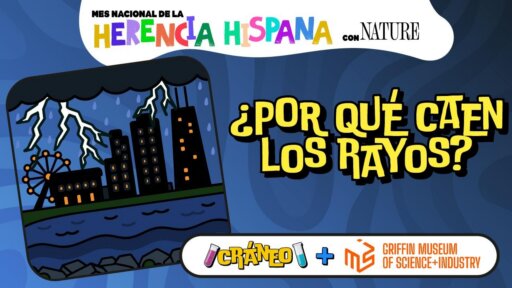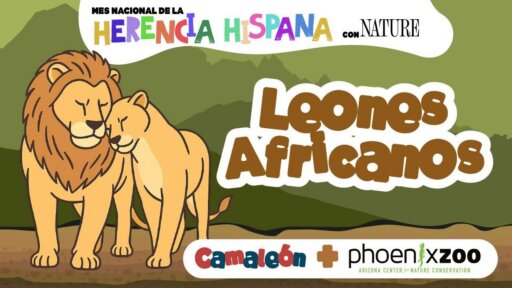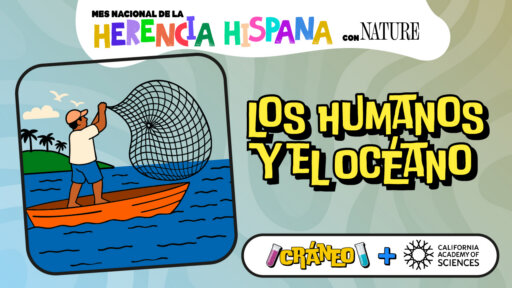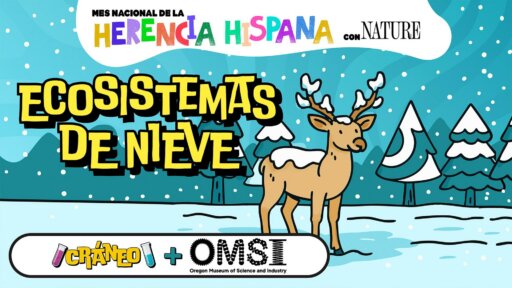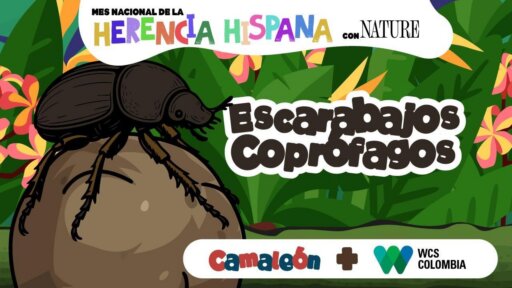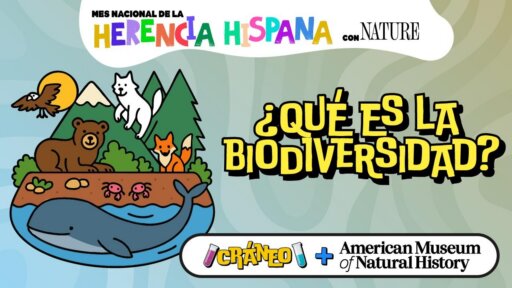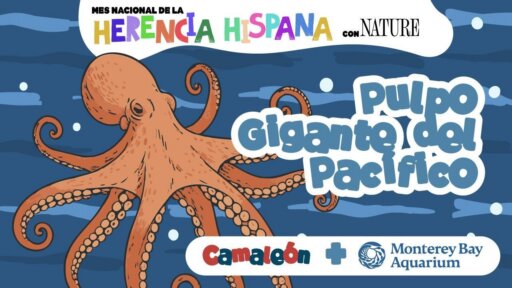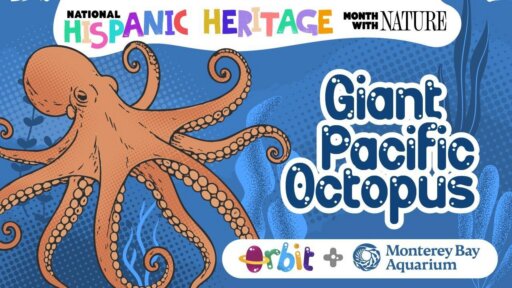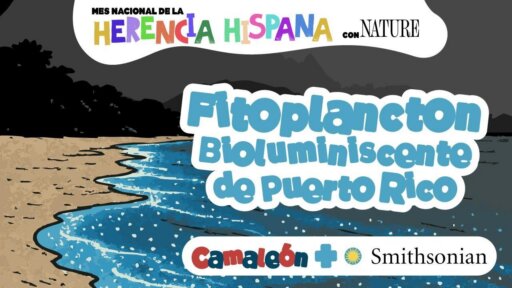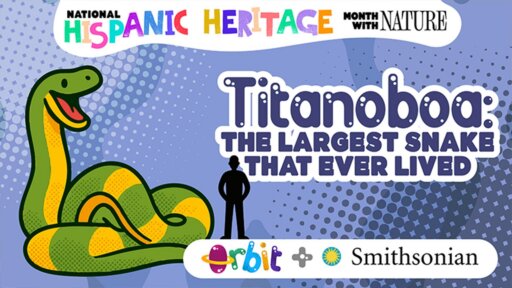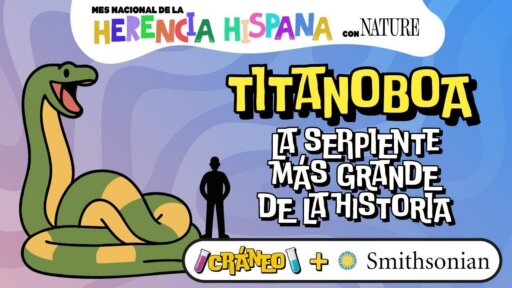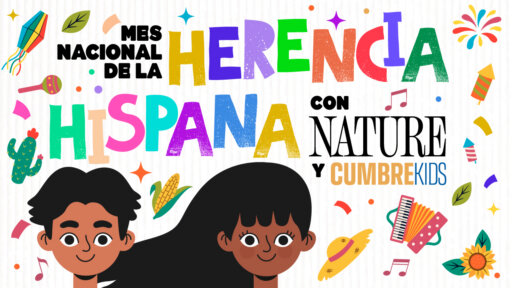TRANSCRIPT (EN)
00:00:00 Robert:
Hi there, Rob here.
00:00:01 Robert:
This episode is part of a bilingual children’s podcast series for National Hispanic Heritage Month, a collaboration between PBS Nature and Cumbre Kids.
00:00:10 Robert:
This series features scientists from leading museums, zoos, and aquariums across the United States, responding to questions submitted by children three to 10 years old.
00:00:19 Robert:
These episodes appear on the podcasts Orbit: Science for Kids on the Move, Cráneo: Ciencia para niños curiosos, and Camaleón: Animales para niños curiosos.
00:00:30 Robert:
Our podcast is for families with children three to 10 years old and can be found on YouTube, Spotify, Apple Podcasts, or wherever you listen to podcasts.
00:00:38 Robert:
Just a heads-up, this episode is in Spanish.
00:00:41 Robert:
We hope you enjoy it.
00:00:42 Gerwuin:
Hello, parents.
00:00:44 Gerwuin:
This episode is part of a special celebration of Hispanic Heritage Month.
00:00:48 Gerwuin:
We want to give a special thank-you this month to the PBS Nature team, who have been collaborators in making this content possible.
00:00:56 Gerwuin:
And if your little ones want to send questions, they can go directly to www.cumbrekids.org/preguntas
or to the link we’re putting in the description.
00:01:06 Gerwuin:
Alright, now let’s begin.
00:01:09 Gerwuin:
OK, Chameleons!
00:01:15 Gerwuin:
Imagine you’re walking along the edge of a rocky beach after the tide has gone out.
00:01:22 Gerwuin:
Among tide pools and seaweed you discover a long, ribbon-like animal that slides slowly over the wet rocks.
00:01:32 Gerwuin:
It doesn’t have fangs or claws, but it’s a surprising predator.
00:01:38 Gerwuin:
Today we’re going to discover ribbon worms together—creatures that still hold secrets science is trying to figure out.
00:01:46 Kids:
Hello, why…?
00:01:47 Kids:
Why are ribbon worms squished flat and not like other normal worms?
00:01:54 Kids:
How do ribbon worms manage to be so long?
00:01:58 Kids:
Does the slime of ribbon worms…
00:02:01 Kids:
…have an effect on humans, and what effects?
00:02:06 Gerwuin:
And to help with that, we’re joined by a very special guest, Martín Thiel, a marine biologist who has devoted much of his life to studying the oceans and who currently works at the Smithsonian.
00:02:16 Martin:
Well, hello, good morning everyone.
00:02:18 Gerwuin:
Get ready, because together with Martín we’re going to learn facts that will get you thinking about how incredible life underwater can be.
00:02:29 Gerwuin:
Hello, Chameleons! It’s great to greet you in another episode of Camaleón, and today, as has kind of become a habit, our amazing little friend Josué is here with me. Hello, Josué, how are you?
00:02:44 Josué:
Hi, Gerwuin. Hi, Chameleons.
00:02:47 Gerwuin:
So good to have you back here on Camaleón today, Josué. Tell me, how have you been?
00:02:53 Josué:
I’m very happy because over the weekend…
00:02:57 Josué:
…Costa Rica’s independence was celebrated.
00:03:02 Gerwuin:
That’s so cool, Josué. Tell me, how do you celebrate it?
00:03:07 Josué:
On the first day people go out with flags and music to receive the torch, which is the flame of independence.
00:03:15 Josué:
At night the national anthem is sung.
00:03:19 Josué:
And there are lantern parades.
00:03:22 Gerwuin:
Yes, and the next day there are band parades in every town.
00:03:26 Gerwuin:
I love that—the lantern parades, everything to do with the celebration of independence.
00:03:33 Gerwuin:
I love it.
00:03:34 Josué:
By the way, Gerwuin, yes—I won.
00:03:37 Josué:
In a lantern contest run by a cooperative near my house that’s called Cooperativa Victoria.
00:03:46 Gerwuin:
Ah, you won a lantern contest—awesome! That’s great, Josué. And what… I don’t know—what did you win, or what was your lantern like?
00:03:53 Josué:
My lantern was made entirely from recyclable material, and I won lots of packages of coffee.
00:04:01 Gerwuin:
Oh, how cool that you won packages of coffee—I love coffee.
00:04:06 Josué:
Next time I’ll bring you that coffee—it’s really good.
00:04:11 Gerwuin:
Ah, well, I’ll be waiting then, Josué, with that yummy coffee from Costa Rica.
Well, today’s star is the ribbon worm. Had you heard of that worm, Josué?
00:04:32 Josué:
That sounds like a worm used to wrap presents.
00:04:39 Gerwuin:
Well, it doesn’t wrap presents, but it can be super long, like a ribbon. Some are tiny, just millimeters, and others can measure more than 30 meters.
00:04:49 Josué:
Thirty meters—that’s bigger than a whale.
00:04:53 Gerwuin:
Exactly—bigger than a whale. And even though they seem simple, they have a trick: they can shoot out a trunk called a proboscis to catch their prey. Some use it like a lasso; others like a stinger with venom. See?
00:05:09 Josué:
Yes, they’re like a gift lasso.
00:05:14 Gerwuin:
Could be, but it’s super alive, I assure you, I assure you.
00:05:18 Gerwuin:
Alright, but let’s look at it on the screen now, Josué.
00:05:21 Gerwuin:
What are we seeing on the screen?
00:05:23 Josué:
Like some very long spaghetti, and they have little holes on their head, and also like…
00:05:38 Josué:
…it looks like they had their tongue on their tail.
00:05:42 Gerwuin:
Yes, and if you look closely, the first—the first image looks quite long, right?
00:05:48 Gerwuin:
Or there are several that are kind of long.
00:05:51 Josué:
One looks like a Minion.
00:05:56 Gerwuin:
Yes, it looks like a Minion, that’s true.
00:05:58 Gerwuin:
It’s time to make a fun song about this little animal, and today we’re going to do it together with Josué.
00:06:06 Gerwuin:
Josué, let’s sing to all the kids—we ask everyone to stand up, all the Chameleons who can jump with us and enjoy this song we’re going to do today.
00:06:18 Gerwuin and Josué:
Ribbon worm, endless and long, it moves in the water like a…
00:06:23 Gerwuin and Josué:
“Servertín,” with its proboscis it knows how to catch small prey.
00:06:28 Gerwuin and Josué:
That it wants to hunt.
00:06:31 Gerwuin and Josué:
It’s very thin, it looks like a lasso; it stretches and coils slowly; it has no legs and no arms either, but in the sea it becomes a beacon.
00:06:44 Gerwuin and Josué:
Ribbon worms, endless and long, they move in the water like a “serbertín”; with its “purpose” it knows…
00:06:52 Gerwuin and Josué:
…how to catch the small prey it wants to hunt.
00:06:58 Gerwuin and Josué:
Some really measure in meters—perhaps the biggest in the world.
00:07:03 Gerwuin and Josué:
Even if their appearance might scare you,
00:07:06 Gerwuin and Josué:
they don’t usually harm humans.
00:07:10 Gerwuin and Josué:
Ribbon worms, endless and long, a sea mystery that lives there; in seas and rivers it lets itself be found—ribbon worm, let’s sing!
00:07:29 Josué:
Today we’re joined by Professor Martín Thiel, a marine scientist from the Smithsonian.
00:07:36 Josué:
Welcome, Martín—do you have a favorite animal?
00:07:39 Martin:
My favorite little animal, as you’re about to hear in what follows, is these ribbon-shaped worms.
00:07:47 Josué:
Martín, what do you do in your work at the Smithsonian?
00:07:50 Martin:
We specifically work at the Smithsonian Environmental Center,
00:07:57 Martin:
where we research the ecology and biodiversity of ecosystems.
00:08:02 Josué:
How interesting! And tell me, how did your love for science begin?
00:08:06 Martin:
Well, really we could start a very long time ago when my family—my parents and my siblings—and I went to the beach, and that’s actually where my love for the sea began a bit.
00:08:24 Martin:
But then life took many turns and I came to Chile, where I have worked for almost 25 years as a professor of marine biology at a university, and a few years ago the opportunity came up to work in this international MarineGeo network at the Smithsonian.
00:08:48 Gerwuin:
Thank you very much, Martín.
00:08:50 Gerwuin:
Alright, Josué, how about we go and discover together the secrets of these…
00:08:54 Gerwuin:
…little worms.
00:08:55 Josué:
Yes, let’s begin.
00:08:59 Gerwuin:
Great, now the time has come to get to know them better.
00:09:01 Gerwuin:
Martín, tell us: what exactly are ribbon worms, and where can we find them?
00:09:07 Martin:
Well, as the name already says, they are worms and are shaped like a ribbon.
00:09:14 Martin:
And in fact, they live everywhere.
00:09:18 Martin:
There are about 1,300 different species.
00:09:24 Martin:
The vast majority of them live in the sea, but we also have some species that live in freshwater. So, if you’re near a lake or a river, it could be that there are these nemerteans there, and there are even some that live on land—obviously on land that’s very humid, because as worms they don’t have anything to protect them from, for example, too much sun, so they need moisture. But the great majority live in the sea.
00:09:31 Gerwuin:
So they can practically be anywhere. And what about size, Martín? Because there’s a very curious Chameleon here.
00:09:38 Álvaro:
Hello, I’m Álvaro, I’m 6 years old.
00:09:41 Álvaro:
I live in Lima, Peru, and my question is: how long can ribbon worms get?
00:09:48 Martin:
Well, Álvaro, thank you very much for that question. They can be almost any size you can imagine, right? They’re long worms—some are tiny, very short, just a few millimeters.
00:10:05 Martin:
Like a fly, right? But others are bigger than a truck.
00:10:11 Gerwuin:
Wow.
00:10:11 Gerwuin:
And what is the name of that huge worm, so I can greet it when I see it?
00:10:15 Martin:
It’s called Lineus longissimus, and it lives on the coasts of the North Atlantic and measures up to 30 meters.
00:10:24 Gerwuin:
Ha! Did you hear that, Chameleons?
00:10:26 Gerwuin:
That big worm can measure up to 30 meters.
00:10:30 Martin:
That’s longer than the largest whale in the world.
00:10:35 Martin:
But in general, most nemerteans are roughly normal worm sizes—right?—a few centimeters. You can imagine them as about the length of an earthworm; that’s the size of most nemerteans.
00:10:56 Gerwuin:
Okay, Martín, I’m already amazed by this little animal, but let’s keep listening to the Chameleons’ questions.
00:11:02 Martin:
Let’s do it.
00:11:04 Manuel:
My name is Manuel, I’m 8 years old, I live in Chile, and my question is: how do ribbon worms manage to be so long?
00:11:15 Martin:
Yes, Manuel, that’s a really good question.
00:11:19 Martin:
Thank you very much.
00:11:21 Martin:
As we’ve already said, nemerteans are worm-shaped, like a little cord, almost like spaghetti, right?
00:11:30 Martin:
And they live on the sea floor, so the sea floor itself supports them, and there they move slowly, dragging their whole body along with them,
00:11:43 Martin:
and moving forward in search of their food.
00:11:47 Gerwuin:
So even though they’re extremely long, the sea helps support all that body.
00:11:52 Gerwuin:
And how do they keep other animals from eating them,
00:11:56 Gerwuin:
since they look like a giant spaghetti noodle—
00:11:58 Gerwuin:
and I like spaghetti so much?
00:12:00 Martin:
Well, that’s because these nemerteans have substances
00:12:06 Martin:
that other animals don’t like.
00:12:09 Martin:
If a fish, for example, eats a nemertean—puts it in its mouth—after tasting it, it spits it out and leaves it there.
00:12:20 Gerwuin:
How crazy! So they have a kind of natural protection?
00:12:25 Martin:
And that’s why sometimes, when you look for these nemerteans and you find them,
00:12:33 Martin:
they have these striking colors that can be orange, or white with color patterns that you notice immediately, and that’s to warn other animals not to eat them.
00:12:53 Antonio:
Hello, my name is Antonio, I live in Querétaro, Mexico, and my question is, why
00:13:02 Antonio:
are ribbon worms squished flat and not like other normal worms?
00:13:09 Martin:
Right—actually, some of these nemerteans can look squished or flattened, but what’s important to know here is that they can vary their body shape tremendously.
00:13:25 Martin:
For example, at one moment they look like very thin spaghetti,
00:13:30 Martin:
and at another moment the same individual—the same nemertean—can look like a chubby cigar.
00:13:39 Gerwuin:
Wow, what an extreme change! And how do they make that transformation?
00:13:42 Martin:
They do this with their muscular system.
00:13:47 Martin:
Right?
00:13:47 Martin:
They have two types.
00:13:50 Martin:
One musculature is like a thread that runs along the whole body, from the head to the little tail.
00:13:59 Martin:
And if they contract this musculature—we call it the longitudinal musculature because it runs along the entire length, the entire length, of the nemertean—then, if they contract this longitudinal musculature, they shorten.
00:14:18 Gerwuin:
So, as if they were shrinking.
00:14:20 Martin:
Then they have another musculature that is like a belt around the body, around the body, and this one we call the
00:14:29 Martin:
circular musculature, because it’s like a circle.
00:14:33 Martin:
Now, if they contract this circular musculature, it becomes very thin.
00:14:41 Martin:
And as with everything, the body’s material has to go somewhere, so they lengthen again.
00:14:49 Gerwuin:
So, depending on which muscles they use, they can make themselves thicker or thinner.
00:14:54 Gerwuin:
Amazing! And does this same musculature also help them survive in the ocean without breaking or getting tangled?
00:15:02 Martin:
Of course—now, that’s a really good question, right?
00:15:07 Martin:
Indeed, this musculature
00:15:11 Martin:
keeps the body together. But, for example, imagine a 30-meter-long nemertean—how does it manage?
00:15:23 Martin:
And nemerteans also have something like a brain in the head, where they have eyes and also sensors to perceive their food, to find their food.
00:15:40 Martin:
And there they have a brain.
00:15:41 Martin:
And now imagine: this brain has to send a signal to the body—or to the nemertean’s little tail—which is 30 meters back.
00:15:52 Martin:
And that signal has to pass through the whole body to get there.
00:15:57 Martin:
So this is really a miracle—
00:16:01 Martin:
how these nemerteans coordinate their body. Some species even have mini-brains
00:16:12 Martin:
along the way that help make things more efficient, so not all information has to go from the tail to the head and then back again. If something urgent happens—say, someone touches the tail—they can react right there.
00:16:31 Martin:
This nervous system is super important for coordinating and for moving around on the sea floor.
00:16:39 Gerwuin:
How incredible, Martín.
00:16:41 Gerwuin:
So, to make it clear: these worms have muscles that run throughout their whole body, and that’s what keeps them firm, even when they measure several meters in length.
00:16:52 Gerwuin:
But it’s not just the strength of the muscles; there’s also their nervous system.
00:16:58 Gerwuin:
In the head they have a tiny brain next to the eyes and some sensors that help them detect their prey.
00:17:05 Gerwuin:
That brain has to send signals to the farthest part of the body, which can be 30 meters away.
00:17:14 Gerwuin:
Wow—imagine how hard it would be to coordinate something like that.
00:17:18 Gerwuin:
Some species don’t depend only on that main brain; they have relay stations along the body.
00:17:26 Gerwuin:
They’re like small nerve centers that help transmit commands faster.
00:17:32 Gerwuin:
That way, if something happens in the middle of the body or near the tail, the worm can react without waiting for all the information to travel from one end to the other.
00:17:42 Gerwuin:
That’s what allows them to move and survive in the ocean.
00:17:46 Gerwuin:
Wow! I’m really amazed by this little worm.
00:17:55 Gerwuin:
Alright, now it’s time for the Chameleon Moment.
00:17:58 Gerwuin:
Our podcast has taken on a mysterious tone to figure out the sound of an animal that you’re about to hear.
00:18:05 Gerwuin:
What animal could it be?
00:18:08 Gerwuin:
Do you have it?
00:18:10 Gerwuin:
Very good—tell me at the end.
00:18:16 Oliver:
Hello, my name is Oliver, I’m 5 years old, living in Santiago, Chile, and my question is: What do ribbon worms eat?
00:18:25 Luca:
Hello, I’m Luca, I’m 10 years old, I live in Panama, and my question is: What do ribbon worms eat?
00:18:34 Martin:
Of course—thank you very much, Oliver and Luca.
00:18:37 Martin:
I was already expecting this question, right?
00:18:41 Martin:
Because it’s super important to know what all the animals that live in the sea eat, and if you look at this worm that doesn’t have many structures—it doesn’t have teeth,
00:18:57 Martin:
or anything like that—
00:18:58 Martin:
you might wonder what they actually eat.
00:19:02 Martin:
Just imagine.
00:19:03 Gerwuin:
It’s true—they look very simple, as if they didn’t have anything to catch or bite with.
00:19:07 Martin:
In reality, they’re organisms that eat other animals.
00:19:14 Martin:
That means they’re predators—and actually quite voracious predators.
00:19:21 Martin:
And they eat animals like crustaceans. Now, what are crustaceans, right?
00:19:27 Martin:
Imagine sand fleas or shrimp, or even crabs.
00:19:34 Gerwuin:
Wow—so they don’t settle for small things; they can go after prey much bigger than you’d imagine.
00:19:42 Gerwuin:
Martín, and off the podcast, you said you have a colleague at the Smithsonian who is researching—or researched—this case with a fiddler crab?
00:19:51 Martin:
Yes, and he realized that at some point some of these fiddler crabs were walking over the salt marshes there, and at a certain moment they became paralyzed in an instant and ended up dead.
00:20:07 Martin:
And at first he didn’t know what was happening.
00:20:10 Martin:
A perfectly healthy crab would be walking and then drop dead from one moment to the next.
00:20:20 Martin:
And later, with careful research, he realized that there were nemerteans at the bottom of these salt marshes.
00:20:31 Martin:
And if a crab walked over one of these nemerteans, the nemertean would attack it, inject a toxin, and then eat that crab.
00:20:46 Gerwuin:
Incredible—that’s a perfect ambush.
00:20:49 Gerwuin:
And you also said there are some that eat worms—worms that eat worms.
00:20:53 Martin:
They paralyze them and then slurp them up like you slurp a spaghetti noodle—whole, without chewing—sucking the other worm along their whole body, through their whole stomach.
00:21:08 Martin:
Now the other worm is inside, and there it’s digested.
00:21:13 Gerwuin:
Hey, Martín, what is that proboscis that ribbon worms shoot out, and how does it work to catch their prey?
00:21:18 Martin:
Of course—this is super, super, super important because
00:21:23 Martin:
the proboscis is basically the big weapon these nemerteans have, right? It’s a proboscis they keep inside their body, and normally you don’t see it.
00:21:38 Martin:
But when they encounter prey, they shoot out this proboscis very quickly.
00:21:47 Gerwuin:
Right, and they’re very clever; they move very slowly along the seafloor or sometimes, as Martín says, in the salt marshes—which are basically like swamps—they hide and don’t move at all, just waiting.
00:22:00 Gerwuin:
But when they come across prey—boom!
00:22:04 Gerwuin:
In an instant that proboscis shoots out and attacks.
00:22:07 Martin:
There are two major groups of nemerteans.
00:22:11 Martin:
We talked about those nemerteans that eat crustaceans, like these crabs, right? And you’ve seen that crustaceans—crabs—have a shell, which is hard. So how can the nemertean now…
00:22:31 Martin:
get through that? Since it doesn’t have teeth or fangs, right, how can it get to this shell that’s a defense? These nemerteans have, at the tip of their proboscis, a stylet that’s like a tooth, like a syringe.
00:22:53 Martin:
And this can go through the crab’s shell, and there they inject a toxin.
00:23:00 Martin:
And this immediately leaves that little crab—or the shrimp or sand flea they eat—paralyzed in an instant.
00:23:12 Gerwuin:
Chameleons, there’s an aspect of ribbon worms we rarely mention—their evolutionary history.
00:23:18 Gerwuin:
These animals belong to their own phylum, Nemertea.
00:23:22 Gerwuin:
And what’s interesting is that they don’t have very close relatives that we know well.
00:23:27 Gerwuin:
That makes them a key group for understanding how life has diversified on the planet.
00:23:33 Gerwuin:
Scientists believe nemerteans appeared hundreds of millions of years ago, long before dinosaurs existed.
00:23:42 Gerwuin:
They survived mass extinctions, drastic climate changes, and enormous transformations in the oceans.
00:23:50 Gerwuin:
And they managed it thanks to their unique adaptations: a flexible body, a versatile muscular system, and of course, their proboscis.
00:23:59 Gerwuin:
We’re not just looking at a curious marine predator; we’re looking at an ancient lineage that has withstood the passage of time and holds clues about the evolution of animals.
00:24:11 Gerwuin:
Remembering this helps us value not only what the worms do today in ecosystems, but also the long history of life that
00:24:20 Gerwuin:
they represent.
00:24:27 Gerwuin:
Alright, but let’s keep listening to the mystery animal.
00:24:31 Gerwuin:
What animal could it be?
00:24:33 Gerwuin:
Could it be a hen?
00:24:37 Gerwuin:
Could it be a rabbit?
00:24:39 Gerwuin:
Or could it be a weasel?
00:24:43 Gerwuin:
Do you have it?
00:24:45 Gerwuin:
Very good—tell me at the end.
00:24:50 Simón:
I’m Simón, I’m 7 years old, I live in Cali, Colombia, and my question is: Does the slime of ribbon worms have an effect on humans, and what effects?
00:25:07 Martin:
No, not really—because first, these toxins…
00:25:12 Martin:
We’re talking about small crabs; and nemerteans, like many other animals, get scared when a big human comes along, and they withdraw, they contract, and don’t do anything.
00:25:29 Martin:
They will never, ever shoot their proboscis at you—but if that were ever to happen at some point—
00:25:36 Martin:
as for me, I’ve studied them—let me think—for almost 40 years of my life, and they’ve never shot a proboscis at me. I’ve handled, moved, touched hundreds and perhaps thousands of nemerteans in my life, everywhere.
00:25:57 Martin:
So they are not dangerous to humans.
00:26:03 Violeta:
Chameleon, my name is Violeta, I’m 7 years old, in Santiago, Chile, and my question is: How many years can ribbon worms live?
00:26:17 Martin:
Now, that’s a very good question, Violeta, and actually—
00:26:24 Martin:
my answer is going to be a bit ambiguous—not very clear—because we haven’t really studied it very well, but we’ve done some research.
00:26:40 Martin:
We, for example, have done experiments where we kept these nemerteans, and during this experiment…
00:26:50 Martin:
Many of these nemerteans lived half a year.
00:26:55 Gerwuin:
What did you discover in that experiment, in that half-year when you were observing the nemertean?
00:27:00 Martin:
We kept them for half a year in the laboratory.
00:27:04 Martin:
But when they arrived at our laboratory, they were already large, and at the end of the experiment they were still alive.
00:27:14 Martin:
So we don’t really know how many years they can live.
00:27:20 Martin:
We don’t have good knowledge—and for many species,
00:27:25 Martin:
we don’t know very well what they eat. In a few species—especially those that live near the beach on the coast—
00:27:36 Martin:
there we have a somewhat better idea.
00:27:39 Martin:
But there are other species, especially those of the deep ocean, where we’ve seen the species but don’t know how they live.
00:27:49 Martin:
One question you haven’t asked me is how they reproduce.
00:27:55 Martin:
We also have very little knowledge there, and in the few species that have been studied, very interesting things have been found—there are even species
00:28:08 Martin:
that care for their eggs, that care for their young,
00:28:12 Martin:
which is very unusual for a worm, or for a marine worm.
00:28:19 Martin:
So there is a lot to investigate there.
00:28:22 Martin:
And the other thing that is actually especially relevant to us is these toxins,
00:28:29 Martin:
because there may be a great variety of toxins there,
00:28:34 Martin:
and some of these toxins could be useful for us.
00:28:39 Martin:
We could use them.
00:28:41 Martin:
For example, there are colleagues who have done some research on nemertean toxins and who think they might be used for insecticides.
00:28:56 Gerwuin:
How fascinating, Martín.
00:28:57 Gerwuin:
I hope you can keep discovering much more.
00:29:00 Gerwuin:
We’ll be paying close attention to you.
00:29:02 Gerwuin:
We’re getting to the end, but first let’s review what we learned, Chameleons.
00:29:07 Gerwuin:
Today we discovered a lot of things about ribbon worms.
00:29:11 Gerwuin:
We learned that they can live almost anywhere—at sea, in rivers, lakes, and even in damp soil on land.
00:29:17 Gerwuin:
We also learned that there are tiny species just millimeters long and others that reach 30 meters—longer than a blue whale.
00:29:26 Gerwuin:
We saw that their body is very special: thanks to two types of musculature, they can make themselves very thin or thick—fatten up or slim down depending on what they need—and they also have a nervous system capable of coordinating a very long body, with mini-brains that help transmit signals faster.
00:29:45 Gerwuin:
We discovered that they are voracious predators.
00:29:48 Gerwuin:
Some hunt crustaceans like crabs or shrimp, others feed on worms or clams, and all use their proboscis along with toxins to paralyze their prey.
00:30:00 Gerwuin:
And although they’re so effective at hunting, they are not a danger to humans.
00:30:05 Gerwuin:
Martín, thank you so much for helping us understand so much about this worm.
00:30:09 Martin:
Well, I hope you’ve learned something about nemerteans.
00:30:14 Martin:
As you’ve heard, they’re super entertaining animals, and there’s still so much we don’t know about them.
00:30:24 Martin:
So, as we’ve said, when you grow up and want to be a marine biologist to study these nemerteans or other fascinating animals that live in our oceans, we need you—we need
00:30:41 Martin:
people who do research, and especially today we also need people who observe in nature.
00:30:49 Martin:
Thank you very much for listening, and many greetings.
00:30:54 Gerwuin:
Alright, let’s congratulate the Chameleons.
00:30:56 Gerwuin:
Today we celebrate the life of Edgardito, from Puerto Rico, who enjoys cows and horses.
00:31:01 Gerwuin:
Happy birthday! And we also congratulate Salvador from Castro, Chile, whose favorite animal is the octopus.
00:31:08 Gerwuin:
I love octopuses—may it be a year full of surprises.
00:31:11 Gerwuin:
A big hug, Chameleons—happy birthday.
00:31:20 Gerwuin:
And many thanks to Luz Soto from Santiago, Chile, for supporting Camaleón.
00:31:25 Gerwuin:
Hugs.
00:31:29 Gerwuin:
Okay, Josué, we just heard Martín talk about animals as incredible as ribbon worms.
00:31:36 Gerwuin:
What did you think of Martín?
00:31:37 Josué:
Amazing—I loved the conversation.
00:31:41 Gerwuin:
Did you learn a lot? Yes, a ton. Alright, because we have the Chameleon Challenge here—let’s see how many things, or how much, we remember of what we learned. I have some questions; you also have others. So let’s begin, yes? Okay, I’ll start. Question number one: Where do ribbon worms live?
00:32:03 Josué:
In freshwater, in the sea, or in damp soil.
00:32:07 Gerwuin:
Correct, Josué—correct. Very good.
00:32:10 Gerwuin:
Very good, very good, very good, very good, very good.
00:32:14 Gerwuin:
Let’s see—do you have one?
00:32:15 Josué:
How long can they get?
00:32:18 Gerwuin:
How long can they get?
00:32:20 Gerwuin:
Let’s see, let’s see what the Chameleons say.
00:32:24 Gerwuin:
I think some can measure just tiny millimeters, but there’s a species that can reach up to 30 meters long.
00:32:32 Josué:
Very good—that’s right.
00:32:34 Gerwuin:
Very good, perfect.
00:32:37 Gerwuin:
Perfect, perfect.
00:32:40 Gerwuin:
Next question: How do they hunt their prey, Josué?
00:32:44 Josué:
They use their proboscis.
00:32:46 Gerwuin:
Very good, Josué—perfect, perfect, perfect.
00:32:52 Josué:
What do ribbon worms eat?
00:32:55 Gerwuin:
What do ribbon worms eat?
00:32:57 Gerwuin:
Let’s see, kids, Chameleons—what do you think?
00:32:59 Gerwuin:
Help me out.
00:33:02 Gerwuin:
I think they’re voracious predators.
00:33:04 Gerwuin:
They can maybe eat crustaceans, other worms, or even clams.
00:33:11 Josué:
Yes, that’s the correct answer.
00:33:13 Gerwuin:
Josué, perfect.
00:33:17 Gerwuin:
Perfect, perfect.
00:33:19 Gerwuin:
We did it, Josué—we’ve won this battle of questions.
00:33:24 Gerwuin:
Now, what do you think comes next?
00:33:26 Josué:
The mystery sound.
00:33:36 Gerwuin:
What animal could it be, Josué—could it be a hen, could it be a rabbit, or could it be a weasel… a rabbit?
00:33:57 Gerwuin:
On the count of three, Chameleons—one, two, three—and it’s a rabbit! It’s a rabbit, Josué, like your little bunny—you did it, you did it. Alright, we’re almost at the end of this episode, Josué; let’s do the credits. In executive production—
00:34:18 Josué:
Robert Carpenter. In graphic design, Moisés Monsalve.
00:34:24 Gerwuin:
And for the illustrations, Jorge Wake. I’ll say goodbye.
00:34:27 Gerwuin:
Many thanks to all the Chameleons for listening to this episode.
00:34:30 Gerwuin:
Thanks for always being there. Say goodbye to everyone, Josué—
00:34:31 Josué:
Bye, Chameleons.

